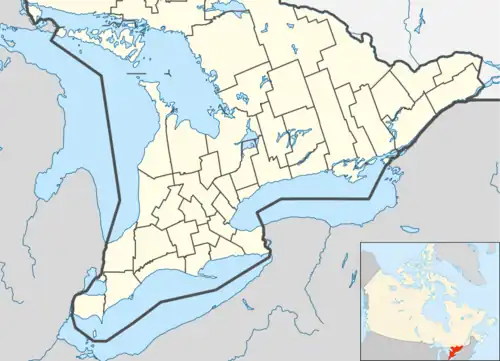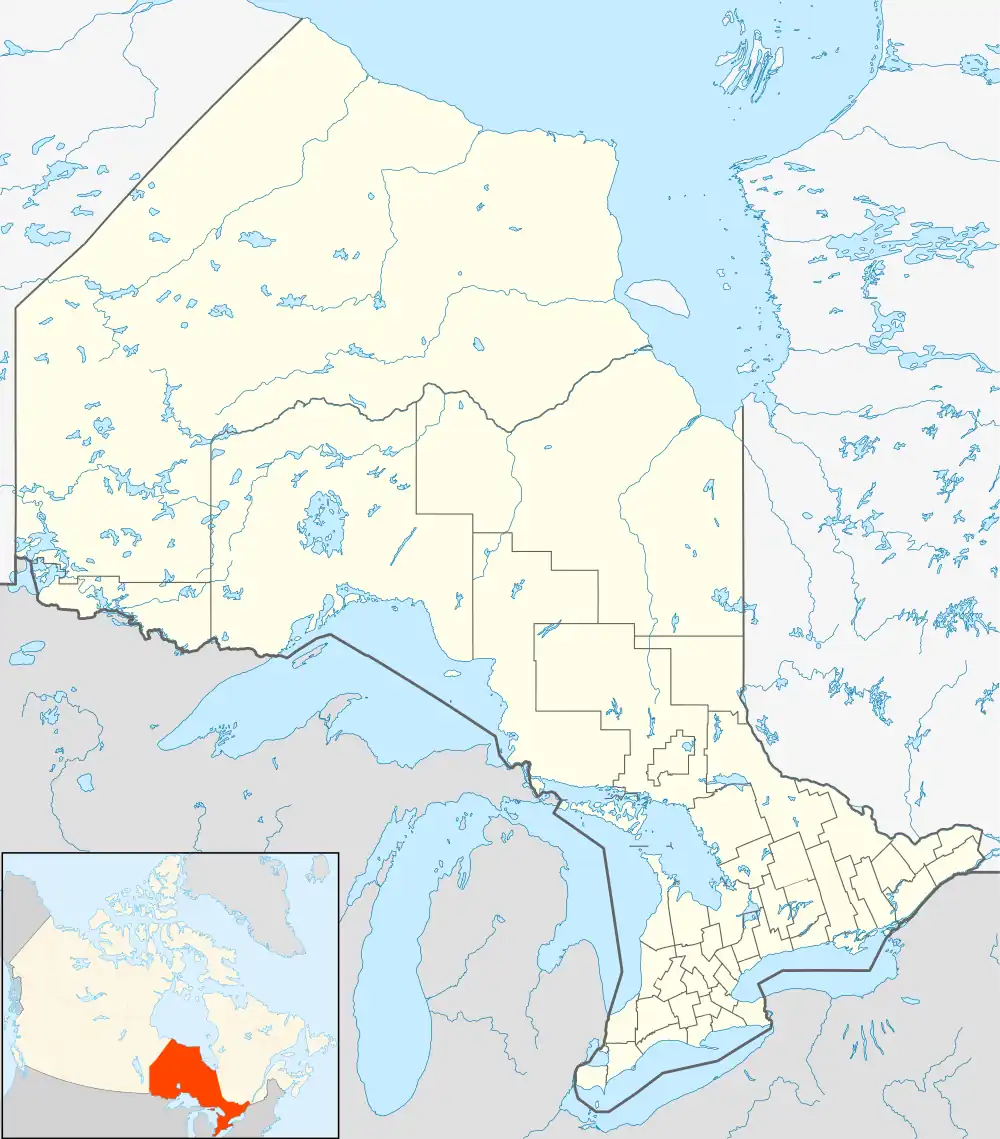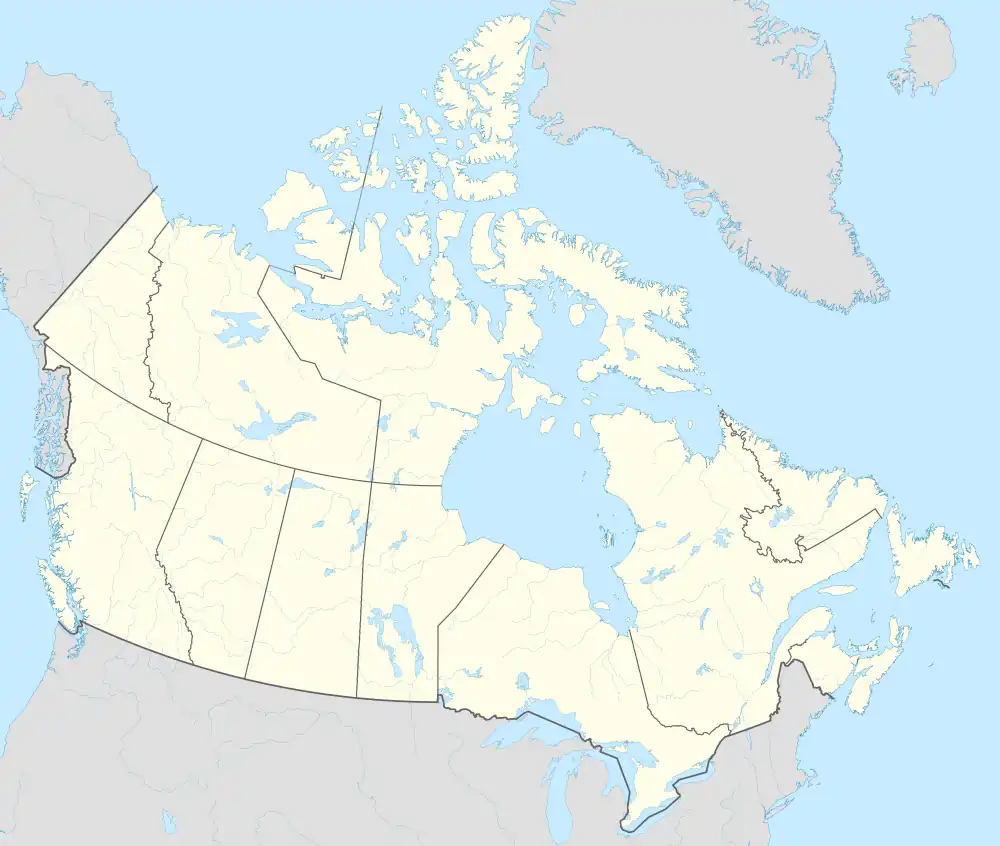Cornell | |
|---|---|
Unincorporated community | |
.jpg.webp) Cornell street scene | |
 Cornell Location within southern Ontario  Cornell Location within Ontario  Cornell Location within Canada | |
| Coordinates: 43°53′30″N 79°13′30″W / 43.89167°N 79.22500°W | |
| Country | Canada |
| Province | Ontario |
| Regional municipality | York |
| City | Markham |
| Established | 1999 |
| Population (2011) | |
| • Total | 9,880 |
| Time zone | UTC-5 (EST) |
| • Summer (DST) | UTC-4 (EDT) |
| Area code(s) | 905 and 289 |
Cornell is a new community village being developed in northeast Markham, Ontario and bounded by Highway 407, 16th Avenue, Ninth Line, and the Donald Cousens Parkway. The 2011 population of this area was 9,880. Adding Cornell North's 2,178 (from 16th Avenue to Donald Cousens Parkway) it had 12,058 residents.[1]
History
Cornell was conceived in the 1990s planning process by the town of Markham. Unlike other Markham communities, Cornell is a planned community.
One of the original settlers was Christian Reesor. He and his family settled in Cornell. Their original homestead was on Reesor Road. The name 'Cornell' derives from the maiden name of the wife of Christian Reesor's youngest son, who continued to live at the family homestead.[2]
William Cornell
Cornell's name was selected in 1999, and is named for the Cornell family, headed by William C. Cornell (1766-1860), which came to Canada from Rhode Island in 1799, and eventually settled in Markham, Ontario.[3]
Ressors
The area had initially been settled by Peter Reesor, who is credited as the founder of Markham, Ontario, but many other properties would be owned by Ressors' as well into the mid to late mid 19th century.[4]
Community description
Most of the houses are townhomes, semi-detached, or detached houses with garages at the rear. The communities are built with central amenities in order to contain suburban sprawl. Cornell was seen by the Markham Town Council as a way to deter the ongoing sprawl by encouraging residential density. The community, particularly Cornell Village, is designed as a walkable neighbourhood with a variety of housing types and retail. Cornell Village, between Highway 7 and 16th Avenue, is fully populated with medium density residential. The southern section of Cornell (south of Highway 7), however, is not fully populated, and remained as a wild field and a farm east of Bur Oak, but began re-developed as South Cornell in 2022.[5] In 2012, the City of Markham completed Fire Station 99 to serve the area.
Transportation
Public transit
Cornell Terminal serves Cornell with several York Region Transit, VIVA, and GO Transit routes:
YRT/Viva:
- Route 1 Highway 7
- Route 2 Milliken (weekends only)
- Route 9 Ninth Line
- Route 14 14th Avenue
- Route 16 16th Avenue
- Route 18 Bur Oak
- Route 25 Major Mackenzie
- Route 522 Markham Community
- Viva Purple
GO Transit:
- Route 52 Oshawa - Hwy 407 Bus Terminal
- Route 56 Oshawa - Oakville
The plans for the new terminal include connections with Durham Region Transit.
YRT Route 303 Bur Oak Express also provides an express service connecting Cornell to Finch Bus Terminal, bypassing Cornell Terminal.
Road
Major roads and highways in the community include:
Arterial roads
- Highway 7 (York Regional Road 7 runs east-west that runs through the centre of Cornell from Donald Cousens Parkway to Ninth Line. Formerly provincial Highway 7, it was downloaded to York Region.
- 16th Avenue (York Regional Road 73) runs east-west on the north side of Cornell.
- 9th Line (York Regional Road 69) runs north-south on the west side of Cornell.
- Donald Cousens Parkway (York Regional Road 48) runs north-south on the east side of Cornell.
Secondary roads
Cornell Centre Boulevard
Cornell Centre Boulevard is a secondary road in the east side of Cornell that runs north-south from Highway 7 to 16th Avenue to divert traffic from Highway 48.[6] Formerly known as Markham Bypass and renamed in 2004. The section south of Shady Oaks Avenue to Highway 7 will be closed to be re-routed and connected as part of the existing William Forster Road. The northern section from Shady Oaks will remain and likely become part of Church Street. Small signage has been added referring to this road as Old Markham By-Pass
Bur Oak Avenue
Bur Oak Avenue is a secondary road in the north side of Cornell mainly north-south and curves around north of 16th Avenue to Ninth Line.
Highways
- Ontario Highway 407 is an east-west highway on the southern boundary of Cornell with two exits (Donald Cousens and Ninth Line)
The above roads are heavily travelled by commuters during the weekdays to get around Markham, York Region and down to Toronto.
Parks and recreation
- Cornell Village Park is community park located next to Cornell Village PS
- Donald Cousens Parkway North Berm and Flatlands - naturalized area on the northeast corner of Ninth Line and Donald Cousens Parkway in Upper Cornell.
- Grand Cornell Park - features clock tower and bell commemorating the Reesor settlers in the area; park is unfinished due to stoppage of development east of the Little Rouge Creek
- Oakmoor Pond - man made marshes that drains Little Rouge River
- New Union Park - renamed and signs installed after local veteran McCowan Freeman in 2017
- Burkholder Parkette
- Shania Johnstone Parkette
A number of smaller parks dot the area and do not have any names. City owned parks are maintained by parks staff year round.
Cornell Community Centre

Cornell Community Centre features a library, community rooms and an indoor swimming pool
Planned development
- Lindvest Condo and Retail Development - 1,300 condo units, 50 live/work and commercial/retail/office space located on the South side of Highway 7. Alfred Roffey Park is small park will be located at the corner of Highway 7 and Ninth Line. Named for RCAF Sgt Alfred Victor Roffey of Markham who died in training accident with RAF No. 7 Air Gunnery School (RAF Stormy Downs) north of Bridgend, Wales in 1942. The park formed from triangular lot created when Highway 7 was rerouted around 1960 to correct broken intersection and part of the extension of the Highway from Peterborough to Ottawa.[7]
- Jade Garden at Cornell.
Education
- Cornell Village P.S: accepts students mostly from Cornell.
- Little Rouge P.S: located in Cornell North. Students living in Grand Cornell, Cornell Rouge, Cornell and Upper Cornell and students from the farmlands northeast of Markham attend Little Rouge Public School.
- Black Walnut P.S: The significance of the school's name is from the fact that Black Walnut trees grow best in deep, fertile soil. When settlers came to Markham, more than two centuries ago, they saw Black Walnut trees growing. They knew this was a good sign that they had found an area that would be good for farming. More than 65 German Pennsylvanian families, many of them Mennonites, came to Southern York Region because of, indirectly, the Black Walnut.[2]
- St. Joseph C.E.S. - opened in 2014
- Bill Hogarth Secondary School - opened in September 2017 with a secondary French Immersion program serving east Markham and Whitchurch-Stouffville, located on Bur Oak Avenue near Cornell Community Centre.[8]
- The York Region Catholic School Board has a site reserved for a secondary school on the east side of Bur Oak Avenue facing the Cornell library.
- YRDSB has a site on the future extension of Bur Oak Avenue south of Highway 7.

See also
- Thomson Memorial Park - home to Charles Cornell House built by Charles Cornell, a descendant of William Cornell in 1858 (relocated from Markham Road)
References
- ↑ http://geodepot.statcan.gc.ca/GeoSearch2011-GeoRecherche2011/GeoSearch2011-GeoRecherche2011.jsp?
- 1 2 "WARD 5 ROUND UP" (PDF). Archived from the original (PDF) on 1 February 2014. Retrieved 27 January 2014.
- ↑ Cornell
- ↑ "Historic map". utoronto.ca. Retrieved 25 June 2023.
- ↑ "South Cornell (Markham) | UrbanToronto".
- ↑ "Markham Bypass". Archived from the original on 8 November 2004.
- ↑ http://www.thekingshighway.ca/Highway7.htm
- ↑ "York region district board" (PDF). civicweb.net. Retrieved 25 June 2023.